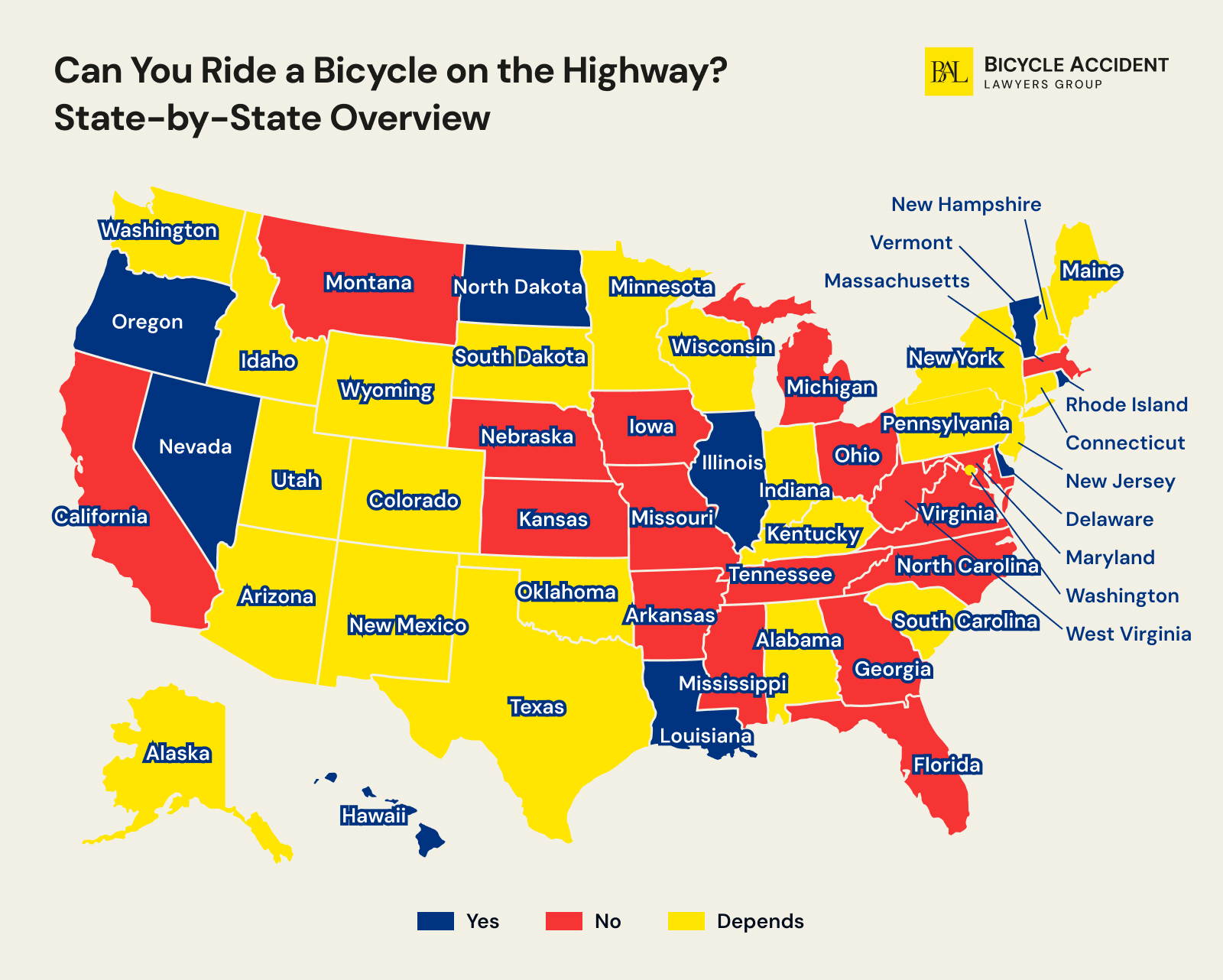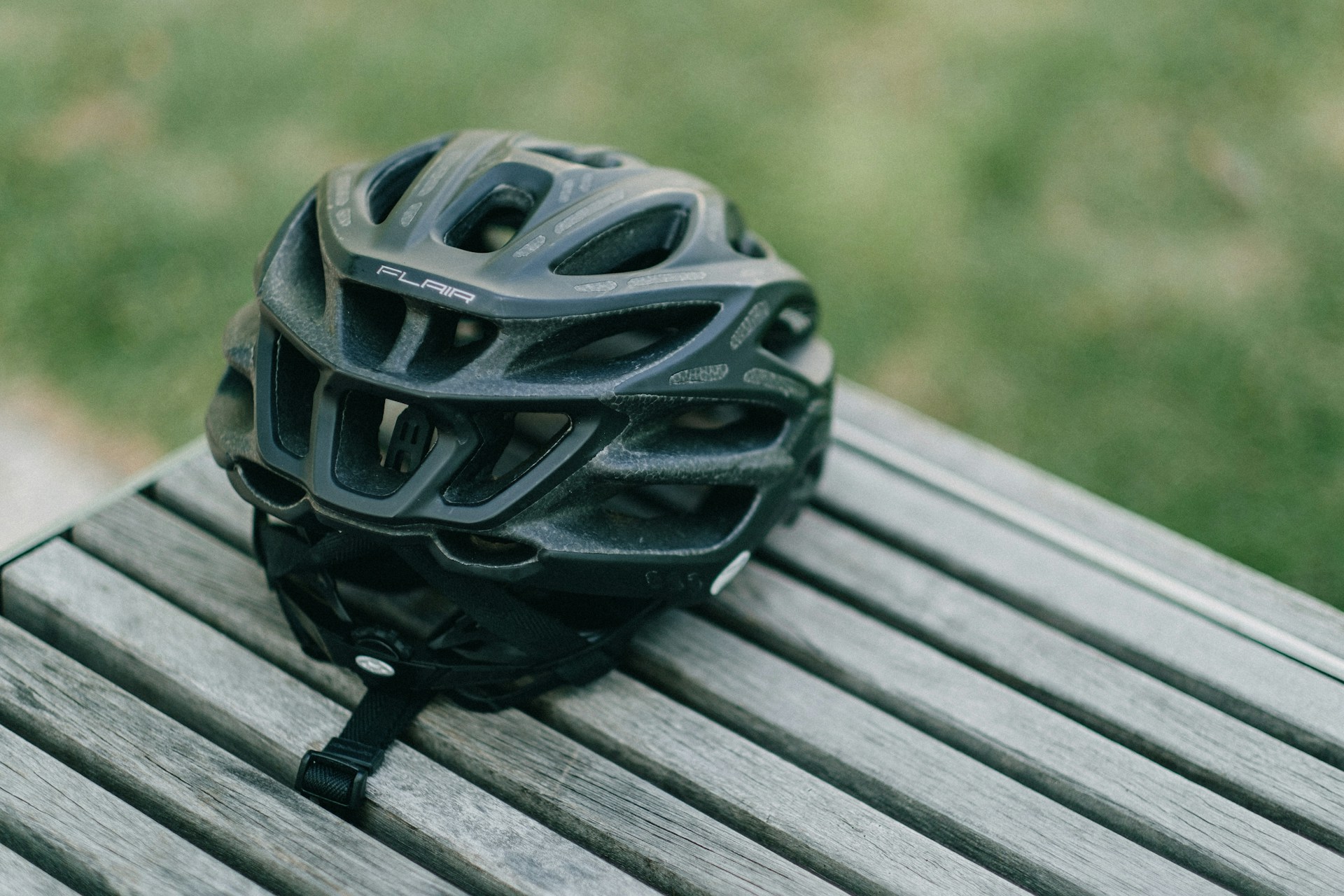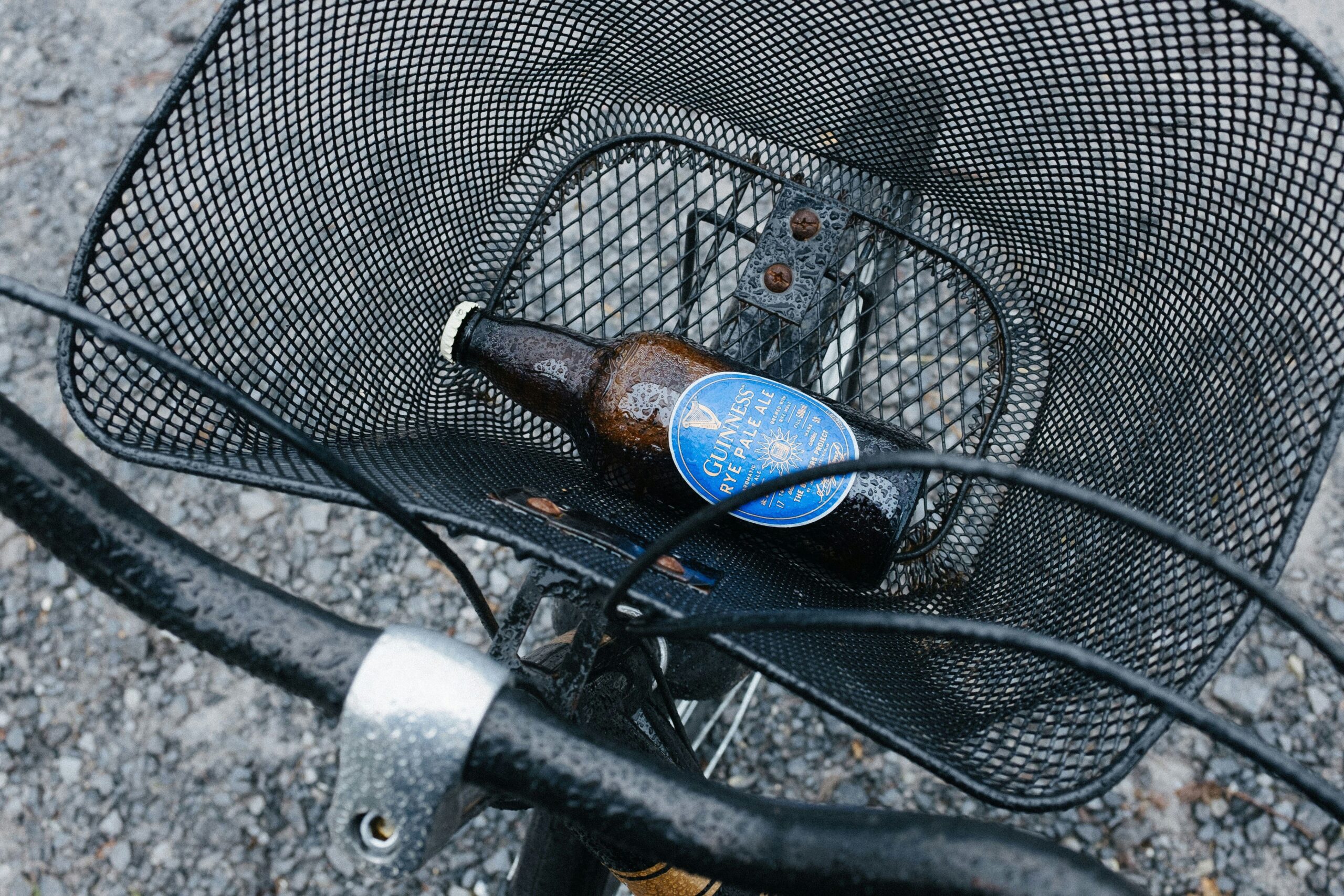In general, riding a bicycle on highways—especially interstates or expressways—is not permitted due to safety and speed-related concerns. Although bicycles are usually allowed on public roads, exceptions apply to controlled-access highways where signage explicitly prohibits them. For example, in Massachusetts, bicycles are permitted on all public roads except limited-access or express state highways where they are specifically banned by posted signs.
A highway may seem like a perfect route for fast and unobstructed cycling. Besides, wide shoulders offer a lot more space than urban roads and appear to be quite an alternative to highly congested areas of a large city. However, what are the legal implications of this issue? Can you ride a bicycle on the highway in the USA?
In America, the legality of biking on highways isn’t exactly straightforward to grasp. Most states have local regulations when it comes to riding a bicycle on highways. Cyclists must familiarize themselves with local ordinances before they choose a route to avoid any legal consequences and other dangers lurking on these high-speed roads.
- Key Takeaways
- Can You Ride a Bicycle on the Highway? Short Summary
- Highway Cycling Rules and Regulations
- What Is a Highway According to Federal Laws of America?
- Can You Ride a Bicycle on the Highway? State-by-State Overview
- Safety Tips for Bike Riding on Highways
- Conclusion
- Get a FREE case evaluation today
Key Takeaways
- Some states allow people to ride bikes on highways, while others forbid the activity altogether or issue local regulations that control the matter.
- Sometimes, highways are the only alternative to choose for direct access to a location or long-distance touring.
- Highways pose palpable risks to cyclists because of high-speed traffic and other conditions.
- Bicyclists must exercise caution and abide by existing traffic rules to stay safe and protected on a highway.
- There are different types of highways in America. Each comes with a set of rules and restrictions to keep in mind.
- Illegal use of highways can lead to fines, citations, removal from the road, and other legal implications.
- A trained legal advisor can instruct you on how to act in case of a bike accident on a highway to protect your rights and ensure a fair outcome of a potential compensation claim.
Can You Ride a Bicycle on the Highway? Short Summary
The answer to the question “Can you ride a bicycle on the highway?” is — it depends. In some states, bicyclists are allowed to use highways, especially if there are no alternative routes to pick from. However, in the majority of cases, controlled-access highways or interstate roads are off-limits for cyclists.
To make sure that you are not breaking any laws, you should be on a constant lookout for signs that indicate local restrictions and requirements. In case you are riding on a highway, you must comply with existing traffic laws and prioritize your safety.
Highway Cycling Rules and Regulations
A local municipality may be given the right to impose individual rules and regulations when it comes to biking on the highway in the region. However, there are also general laws to abide by to enhance your cycling experience. They are the following:
- Bicycles are considered legal vehicles, so cyclists have the same rights as car drivers. However, that means that they must follow the same rules, stop at traffic lights, give right of way, and abide by posted signs to avoid creating dangerous road situations.
- A bike must be fully functional and equipped accordingly with a sound braking system, state-approved front and rear lights, reflectors, and signals.
- Bike riders should always stick to the right side of the road. Riding in a single-file style is also recommended when on the highway. However, if the manner is impossible or seems unsafe, alterations may be permitted.
- A bicyclist must use hand signals when making a shift, turn, stop, or any change in direction.
- Protective gear such as helmets may not be mandatory across the states, but it surely improves the odds of sustaining fewer injuries should an incident occur.
- Riding predictably increases your chances of getting safely from one location to another while on a highway. That is why you should avoid sudden moves and alert other vehicles about your intentions in advance.
What Is a Highway According to Federal Laws of America?
All public roads in the USA fall under the category of a highway. However, you cannot refer to every freeway as a highway, as not all highways are freeways. A highway, a freeway, and an interstate are different types of roads. Depending on the subcategory of a highway, specific rules and traffic regulations may apply. So, let’s have a close look at those and try to figure out what makes them unique, especially from a cyclist’s perspective.
Highways
As previously mentioned, we collectively refer to all public roads as highways. Whether you are riding on a rural road, a city street, or a federal route, you can still be biking on a highway. A highway may differ in size, the types of traffic it allows, and the number of lanes.
However, the main outstanding feature that best describes this type of paved road in the USA is the presence of intersections, traffic lights, adjacent streets, and by-road properties. This type of road may have varying speed limits, which makes it suitable for such activities as cycling.
Freeways
A freeway is also a highway but with a high speed limit and controlled access. Usually, you can’t get on this type of road without a ramp. Furthermore, a notable distinctive feature of freeways would be the absence of intersections and traffic lights and signs. Keep in mind that you can’t access any property directly from a freeway.
Multiple lanes are going in both directions. As the name suggests, freeways can be accessed by anyone without any fees or tolls required. However, bikes are generally forbidden on freeways.
Interstates
An interstate highway is a federally funded type of road. It is a controlled-access highway and often connects major cities across the country. Most interstates are free to access, but there’s a variety of paid roads available. Interstate routes are specifically designed for long-distance travel and heavy traffic. That is why the available lanes and shoulders are usually broader and more efficient.
One of the easiest ways to spot an interstate highway is to look for one- or two-digit numbers. Even numbers go east and west, while odd numbers go north and south. Vulnerable road users such as bicyclists aren’t allowed on these roads unless state law says otherwise.
Can You Ride a Bicycle on the Highway? State-by-State Overview

A freeway or an interstate highway sometimes seems like a lucrative shortcut that can save you the hassle of making a multiple-mile detour. Besides, cycling on a freeway in the USA isn’t always illegal. So, should you seize the opportunity or strategize a longer yet safer journey? There is only one way to figure it out — consult state laws!
Alabama
The state law of Alabama treats bicycles as full-on vehicles, which are forbidden on sidewalks but allowed on public roads. State rules do not prohibit riding on freeways and interstates, per se, but local governments may have a different opinion. So, you should keep an eye out for the corresponding signs when you ride a bike in Alabama.
Alaska
Every bike rider in Alaska has the same rights as the rest of the motorists. They can cycle in a designated bicycle lane or ride on the far right of the road or on a shoulder if it is safe to navigate. There are areas, such as Airport Way, the Johansen Expressway, and the Steese Expressway, which prohibit bicyclists from riding on the road, so you should always check the signs or local municipalities for more information.
Arizona
In Arizona, bicycles are allowed on highways as long as their riders comply with existing traffic rules and regulations. It is possible to navigate through the state using interstates if it is not explicitly forbidden by the local government. Keep in mind that interstate routes are exceptionally dangerous for cyclists since they pose a high chance of a deadly bicycle collision with a car.
Arkansas
Unlike other states, Arkansas law does not view bicycles as lawful vehicles, but they are allowed on all public roads and highways. Moreover, cyclists possess the same rights and duties as other drivers. However, in Arkansas, riders are forbidden access to any freeway.
California
Generally speaking, if you are moving as fast as the rest of the traffic, you are allowed to use any road in California. Even if you can’t ride at the same speed as the rest of the vehicles, you can access most public roads, except for those that feature prohibiting signs. Also, a rider using a regular bike or an electric bicycle is banned from freeways, expressways, and toll bridges.
Colorado
According to Colorado Statutes, bicyclists are rightful traffic participants, which grants them access to public roads on the condition that they comply with local laws and regulations. However, state law entitles local municipalities to change existing norms in order to improve road user safety in the area.
Connecticut
Bike riders in Connecticut have access to most roads and paths in the state, including sidewalks and highways. However, depending on the type of road chosen, the cyclist acquires the rights and duties of either a pedestrian or a motorist, correspondingly. There are limit-access highways that bicyclists aren’t allowed on unless there is a designated path available.
Delaware
The state laws of Delaware stress the fact that local roadways aren’t designed exclusively for car drivers. Cyclists are permitted on highways in the state, too. However, riders must be well-versed in local traffic laws since they can bear full responsibility for an initiated accident.
Florida
Most public roads in Florida are accessible for bike riders. However, bicyclists must ride so that they do not obstruct the traffic flow under any condition. At the same time, cyclists are banned from any limited-access or interstate highway.
Georgia
The state of Georgia views bicycles as vehicles, which makes it legal for them to ride on highways. It is allowed to use roadways if no bike lanes are available. In other cases, cyclists should ride on a designated path. At the same time, bicyclists are barred from using any limited or controlled-access freeways or interstate.
Hawaii
The state of Hawaii does not prohibit riding on a highway. However, there are a few conditions to comply with. Cyclists must use equipped bike lanes when available. You can exit the lane to overtake other road users or steer clear of hazardous conditions. When sharing the road, riders have to ride in a single file.
Idaho
Since bike riders are entitled to the same rights and duties as the rest of the motorists, they are allowed to exploit local highways to their full potential. There isn’t a law forbidding the use of any interstate highway as such, but most local ordinances set limits on cyclists’ access to high-speed routes.
Illinois
General traffic laws apply to bicyclists riding on highways in Illinois. As lawful traffic participants, cyclists can take a full lane when traveling at normal speed. In other cases, they have to stick to the right-hand side of the road as close to the curb as practicable.
Indiana
Cyclists in Indiana can ride on most highways in the state on the condition that they comply with local traffic laws. However, it is advised to use dedicated bicycle lanes to navigate the area and stay as safe and protected as possible. If you are unsure whether you can access a particular road, you can always reach the Indiana Department of Transportation and inquire about the matter.
Iowa
In Iowa, bicycles aren’t defined as vehicles since they are man-powered, but bike riders are allowed to ride on most roads within the state. The exceptions are interstates, highways with a defined speed limit, and local streets that prohibit the activity.
Kansas
Bicyclists are allowed to use public roadways in Kansas if there isn’t a marked bike lane in the area. While on a highway, cyclists must abide by all traffic signs and signals to avoid creating dangerous situations. Non-motorized vehicles, such as bicycles, aren’t generally permitted on an interstate highway unless local ordinances overrule the prohibition.
Kentucky
There are no local laws that either permit or prohibit cyclists to use controlled-access highways or interstates in Kentucky. However, there are some precise requirements when riding on public roads. Bicyclists must use a designated shoulder of a highway when available. They can also take an entire lane if it is exclusively marked for this category of road users.
Louisiana
You can ride a bike on a highway in Louisiana as long as it is adequately equipped and fully functional. Moreover, cyclists must remain on the far right side of the road unless they are riding in an area where two or more marked lanes are heading in the same direction. In that case, cyclists are allowed to stick to the left-hand curb, especially before making a left turn.
Maine
In Maine, cyclists have the freedom to ride anywhere they choose, provided they comply with the current traffic regulations. Bike riders aren’t required to use a dedicated lane even if there is one adjacent to the road they use. However, local governments may prohibit bicyclists from using divided highways.
Maryland
Bicycles are referred to as vehicles in Maryland, meaning that their operators have to comply with all the laws of other motorists. Unlike other states, Maryland prohibits riding on a list of highways and sections of highways.
Massachusetts
Cyclists in Massachusetts are subject to all state-approved as well as local traffic rules. Aside from the obligations, bicyclists have the right to use most public roads across the state. However, any interstate highway is usually off-limits. A dedicated sign will notify a rider about it.
Michigan
You can ride a bike on both sidewalks and roadways in Michigan. When on the road, cyclists acquire the rights of motor vehicle operators. When using the sidewalk, they must abide by the same rules that pedestrians do. You cannot bike on a freeway in Michigan.
Minnesota
Bicyclists are allowed on most state and trunk highways in Minnesota. However, they may be banned from controlled-access freeways if there is a corresponding entrance signature. The high speeds preserved on a major interstate highway pose a danger to such vulnerable road users as cyclists.
Mississippi
According to the state law of Mississippi, cyclists share the same rights and obligations as car drivers. This means that riders can bike across major highways in the state. Yet, the law forbids biking on any interstate highway or controlled-access facility.
Missouri
The state law of Missouri forbids motor vehicle operators from acting in any way that may put bicyclists who share such a roadway with them in any danger. At the same time, cyclists can access most roadways across the state, except for interstates.
Montana
Montana authorities have taken it a step further when it comes to cycling across the state. Not only are bike riders allowed on local highways, but the state has compiled a dedicated guide that any bicyclists can access and use to navigate the area safely. Keep in mind that biking on any interstate route is prohibited.
Nebraska
For the most part, riders are allowed on any public road except for major freeways and interstate highways in Nebraska. However, if there is an equipped bicycle lane in the vicinity, cyclists can’t ignore it and continue on the road; they should always pick a dedicated path over a shared lane. At the same time, interstates and freeways are inaccessible to bicyclists.
Nevada
Unlike most states, Nevada permits bicycles on interstates. Due to the rural nature of the states, cyclists aren’t offered many alternatives. It is important to remember that most interstates have signs posted that require bike riders to exit a highway at one point or another.
New Hampshire
Human-powered vehicles are considered legal traffic participants, meaning that bicyclists have the same rules and obligations as the rest of motorists. Local ordinances may restrict access to specific areas, so it is best to check for those in advance.
New Jersey
New Jersey law doesn’t ban biking on sidewalks, but many towns have local rules prohibiting it in certain areas, usually with signs posted. Sidewalks are meant for pedestrians, and biking on them can lead to conflicts or crashes, similar to riding against traffic. Only very young children under adult supervision should ride on sidewalks.
New Mexico
Aside from local highways, cyclists can use certain sections of controlled-access highways, primarily in rural areas, since recent bicycle accident statistics prove that these locations are less prone to serious incidents than urban roads. An interstate highway that allows biking will be equipped with a special shoulder assigned to riders. Other freeways that prohibit cycling will feature posted signs stating so.
New York
State laws and local regulations may differ across New York State. Generally, cyclists are allowed on most public roads, but certain bridges, freeways, and controlled-access highways may forbid the activity. If general rules don’t apply to an area, a sign will proclaim it. Keep in mind, if you’ve been involved in an incident while biking on a highway, consulting a trained New York bicycle accident lawyer will help you understand your legal options.
North Carolina
Non-motorized traffic isn’t allowed on major interstates and other fully controlled access highways in North Carolina, even though bikes are considered vehicles in the area. You can ride a bicycle on any other public road as long as you comply with traffic regulations.
North Dakota
The state of North Dakota has a couple of unique regulations applicable to bike riders. First of all, cyclists aren’t allowed to use sidewalks to navigate the state. Secondly, bicyclists are permitted to ride a bike on interstate routes.
Ohio
Although cyclists share the same rights and have access to the same areas as motor vehicles, one can’t generally ride a bicycle on a highway. There are certain exceptions, though. A rider may occupy a section of a freeway when directed by a police officer. Also, it is possible to ride next to a freeway where there are dedicated lanes available.
Oklahoma
Bike riding on highways in Oklahoma is generally permitted because bicyclists are considered rightful traffic participants. There isn’t a direct state law that allows or prohibits cyclists’ access to interstate routes or freeways, so they must consult local ordinances to stay on the safe side.
Oregon
Cyclists have a legal right to travel across Oregon’s streets, roads, and highways. Moreover, bicyclists can even access local interstate roads and freeways. Yet, there are a few interstate sections that riders can’t use. For instance, I-84 from I-5 (MP 0) to 122nd Street (MP 10.25) Eastbound and Sandy Blvd (MP 15.14) Westbound in Portland, or I-5 from Barnet Road (South Medford) Interchange, MP 27.58 to the Crater Lake Highway (North Medford) Interchange, MP 30.29 in Medford.
Pennsylvania
Upon first glance at the state’s general regulations concerning bicyclists, it is safe to assume that this type of road user can exploit any street or highway in Pennsylvania. While that is primarily true, cyclists aren’t allowed to be on freeways unless granted a special permit from the Pennsylvania Department of Transportation.
Rhode Island
Local authorities have put a lot of effort into improving cyclist safety. There are over 60 miles of paved bike lanes available. Apart from that, riders can use most public roads for transportation across the state since they are entitled to the same legal rights as car drivers.
South Carolina
Bicycle laws in South Carolina aim to protect cyclists as well as other road users. That is why riders can use highways to navigate across the state, but only on the condition that there are no bike lanes in the vicinity or that they are unsafe to bike on. As for freeways, bicycles aren’t permitted on controlled-access roads unless there are dedicated lanes available.
South Dakota
South Dakota state law claims that bike riders can ride with the traffic. This means that cyclists can use all roadways available except for those that expressly prohibit the activity. However, while navigating high-speed routes, bicyclists must exercise increased caution.
Tennessee
Bicycles are considered vehicles in Tennessee, which means that all legal regulations that govern the operation of cars are applicable to them. Bicycles are permitted on most state roads except those restricted by local authorities. Primarily, the rule applies to interstate routes and limited-access highways.
Texas
Cyclists can explore most roads, including but not limited to highways across Texas. There are a few toll roads and freeways inaccessible to bicycle traffic, such as Sam Rayburn Tollway and US 75. However, you should keep in mind that the Texas Transportation Commission has the right to impose restrictions on alternative routes, so you should always keep an open eye for official traffic-control devices marking the areas.
Utah
Utah remains a pretty bicycle-friendly state when it comes to exploring major roadways on a bike. Some parts of interstate roads aren’t available for cyclists, but fortunately, there are alternative routes to exploit to get to a desired location.
Vermont
Like in most states, you can ride a bicycle across major state highways in Vermont. In fact, it is allowed to cycle on the shoulder of a partially controlled-access route as long as they have safe connections with public roadways.
Virginia
Planning a biking trip in Virginia seems effortless since bicyclists are permitted almost anywhere in the state. You can ride on or off-road in Virginia, choosing the paths that suit your needs and expertise. However, cyclists are banned from all interstates for safety reasons.
Washington
Washington state laws are quite straightforward when it comes to bicycle use on major state roads as well as freeways. Bike riders can ride on highways as long as they abide by existing rules and regulations. Noncompliance with traffic laws may lead to a ticket. Some sections of limited-access routes may be closed to cyclists. Besides, there’s a precise map outlining permanently restricted roads for bicyclists.
West Virginia
West Virginia bicycle laws are pretty similar to those of other states. Bicyclists are allowed to use public roads as well as sidewalks to navigate across the state. Depending on where a cyclist rides, they have to abide by the general guidelines that either motorists or pedestrians follow. At the same time, it is prohibited to ride a bicycle on a high-speed highway.
Wisconsin
The state law of Wisconsin allows bicyclists on all the roads available for motor vehicles, except for a few limited-access roads. High-speed routes are often equipped with wider shoulders that riders can use to enhance their safety. However, high-speed bicyclists can use a full lane.
Wyoming
Bicycle laws in Wyoming are quite sparse when it comes to riding on highways. Since there are no precise regulations restricting bicycle use on freeways and interstates, but cyclists are delegated the same rules and responsibilities as motor vehicle drivers, it is safe to assume that bike riders can exploit high-speed roads. However, it is advised to seek alternative routes to ensure enhanced safety.
Safety Tips for Bike Riding on Highways

Can you ride a bicycle on the highway without putting yourself at risk? Probably not. But there are a few practical tips that can boost your protection on a busy road, no matter the part of the country you are cycling through. They are the following:
- Start with a plan: Whether you are about to explore a new city or want to change your usual route to work, look up available routes. Some may be faster, and some may be safer. We suggest you pick the latter.
- Protect yourself: Most states do not require adult riders to wear protective gear, especially helmets. However, a quality headgear won’t rule out every chance of getting into an accident, but it will decrease the seriousness of your injuries if you happen to hurt your head in the process.
- Choose proper road position: Most state laws require riders to stick to the far right side of the road, but it does not mean that you should ride as close to the curb as possible. Position yourself closer to the center of the lane so that you remain visible to the approaching traffic. In some cases, taking the whole lane is a good choice.
- Scan the surroundings: You should be ultra-vigilant about where you ride. Inspect the road ahead for any potential hazards or obstacles so that you can react on time. Try to monitor other road users at the same time. Be vigilant for vehicles exiting their driveways, opening doors, potholes on a road and other potentially hazardous actions.
- Call a lawyer: Even the most law-abiding and careful cyclists may suffer from other people’s negligence. So, be ready to defend your rights and prove the other party’s liability in an incident. A trained bicycle accident attorney will guide you in the direction of maximum compensation for your injuries and losses.
Conclusion
Cycling is a relaxing and healthy activity, but it comes with a set of legal requirements and responsibilities. Some states choose to expand bicyclist rights while others limit them. However, each local government in the US does so with the sole aim of enhancing riders’ safety while biking on such busy roads as highways. Today, we’ve briefly discussed every state and its views on highway cycling. If you have any questions left unanswered, contact us for a free legal consultation today!






